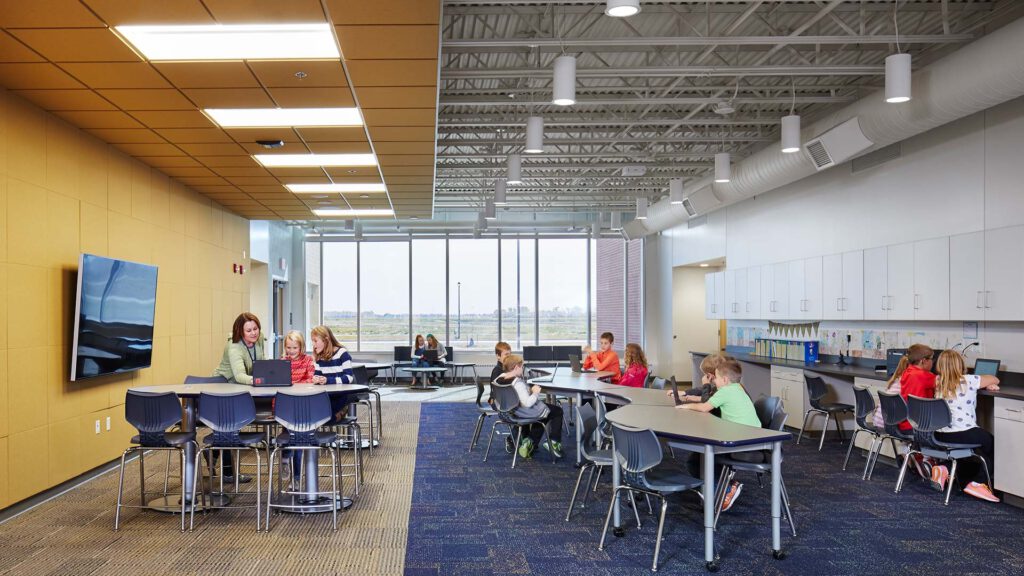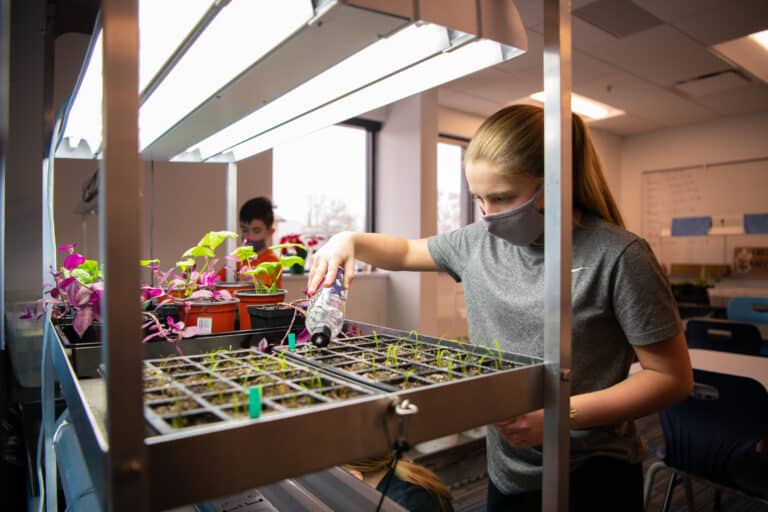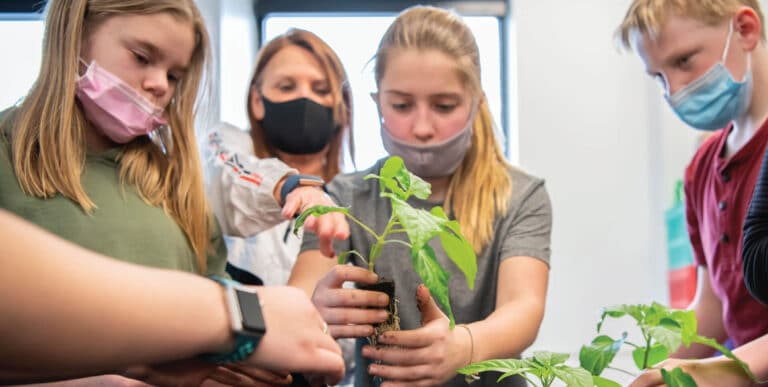Have you ever walked into a space, and it just felt right? Depending on the activity, it was calming or energizing, you were focused or entertained, or you felt welcomed and comfortable. Conversely, have you been in spaces that made you anxious or just plain felt wrong? How we experience the spaces where we live, work, and play impacts how we process the world around us. When these spaces are well-designed and promote the health and well-being of the occupants, we perceive our experience more positively. As educational architects, we know that holistic learning environments that address the physical, social, mental, and cultural needs of students and staff can have a positive impact on their ability to learn, grow, teach and mentor.
The Why
For many students, school is the most accessible place to obtain mental health support. According to the Association for Children’s Mental Health (ACMH), 1 in 5 children and youth have some kind of diagnosable emotional, behavioral, or mental health disorder. Furthermore, 1 in 10 adolescents have a mental health issue serious enough to impair their function at home or in school.1 When students are struggling, focusing on school can sometimes be the last thing on their mind.
The World Health Organization defines mental health as a state of well-being in which every individual realizes his or her own potential, can cope with the normal stresses of life, can work productively and fruitfully, and is able to make a contribution to her or his community.
Breaking Down Social Emotional Learning
Similar to mental health, Social-Emotional Learning (SEL) is another term commonly discussed in education. The Collaborative for Academic, Social, and Emotional Learning defines SEL as “the process through which all young people and adults acquire and apply the knowledge, skills, and attitudes to develop healthy identities, manage emotions and achieve personal and collective goals, feel and show empathy for others, establish and maintain supportive relationships, and make responsible and caring decisions.”
These two concepts work together to support the need for students to be equipped with tools to feel whole in their personal wellness. According to the HMH Educator Confidence Report, 72% of educators cited students’ social and emotional needs as a top concern during the past school year.2 Access to social and emotional learning over the course of the pandemic is resulting in the need for more resources that support student mental health. Some of the most common mental health issues facing students today include anxiety disorders, Attention-Deficit Hyperactivity Disorder (ADHD), Autism Spectrum Disorder (ASD), Eating Disorders, and Mood Disorders. For years, conversations around mental health have been stigmatized, but today, we are seeing the importance of mental health conversations front and center in the headlines and our day-to-day lives.
This leads us to ask — what can the built environment do to support the wellness of those who occupy its space? We want to design learning environments that promote the health and well-being of everyone who interacts with that environment. A building should not be a barrier to supporting the needs of those who use it, but rather a bridge to their mental and social well-being.
Whether you’re looking for a new space that is centered around supporting mental health or looking for small moves you can make today, here are some design guidelines for how your building can support the mental health of staff and students in the most commonly used spaces.
Design Guidelines for Social-Emotional Learning
Building Entry
As they say, you only get one opportunity to create a good first impression — and the site and building entry is a prime opportunity. It sets the tone for how people will respond to what’s happening inside the building and is the face of the community. Helping people feel welcome is a great way to lower anxiety and create connections. Here are a few guidelines to create a positive first impression:
- Have you ever been to a building and had a hard time finding the front door? To calm anxiety and minimize confusion, buildings need to start their welcome on the site, including wayfinding and exterior signage that clearly defines the entrance.
- Visually communicate and welcome guests with local art that reflects the cultures in the surrounding community. Include graphics with elements such as natural landforms, cultural patterns, historical photographs, or man-made landmarks.
- A secure front entry is standard for most education facilities these days. This includes glass to the entry, allowing those in reception to see who is approaching the building. Here, a doorbell/camera system and electric locks prevent visitors from gaining access to the building without checking in and being admitted by school personnel first.
- Provide comfortable space to greet visitors and students as they enter the building. Right-size the space and create opportunities for students to engage with greeters at their level, such as a reception desk with high and low spaces where you can see the faces of adults and students.
- Minimize potential triggers that can cause stress or recall trauma for those entering the building. This could be tight, claustrophobic spaces or crowded spaces that can induce anxiety. Other triggers could come in the form of imagery, active security measures, or overly negative warning signage. Reflect on what triggers may be common in your community and avoid them.
Cafeteria & Commons Spaces
Lunch can sometimes be the most stressful period of a student’s day. What am I going to eat? Where am I going to sit and with whom? How long do I have to eat, socialize, and get my wiggles out where I don’t have to be silent? Here are a few considerations to reduce anxiety and over-stimulation in this often very active space:
- Create a place students want to be and where they can feel comfortable. Students gravitate towards spaces that feel like a coffee shop — with a variety of seating options that provide them with a choice. Instead of a large open space, consider breaking the room up with varying ceiling heights to create a more human-scale experience. Furniture is another way to create a comfortable environment. Try mixing in high tables where students can choose to stand and eat, low round tables that allow students to make eye contact, individual bistro tables for alone time, or soft, comfortable seating that invites students to spend more time in the space.
- Access to basic needs can be a real concern for students. Often, students have extremely short lunch periods or have other activities/meetings coinciding with mealtimes. Providing students with options for when and where they access their food provides them with autonomy and can help relieve stress. This could look like small food kiosks around the cafeteria or dispersed into the learning communities.
- Safe spaces in schools are spaces that are open and visually connected to other spaces rather than a space that is physically and visually removed from its neighboring areas. The cafeteria is commonly seen as the town square, and visually connecting it to other spaces in the building allows for more passive supervision and less bullying.
- Locate mental health support spaces in view and destigmatize access to these services. A balance of privacy and accessibility is the key to destigmatizing these services.
- Consider the power of color, pattern, and materials, along with their cultural significance.
- Don’t forget acoustics and lighting. Cafeterias are often large open spaces where noise from hungry students can become overwhelming and trigger sensory overload.
Public Restrooms & Student Locker Rooms
When talking to school administrators about where they see the most behavioral problems occurring, they inevitably bring up toilet rooms and locker/shower rooms. Administrators and students will note that negative activities such as bullying, gambling, fighting, predatory digital images, vaping, and graffiti, often occur in these areas. These activities can make students feel unsafe in two spaces they have no choice but to use. Here are some opportunities to make these commonly used spaces safer for students:
- Consider creating home-like restrooms that are inclusive to every student. When everyone has access to the same space, students don’t have to question where they belong. These spaces contain private toilet rooms that open to a shared handwashing area and areas of common traffic. This creates more opportunities for passive supervision and reduces opportunities for bullying or other negative activities that make students feel unsafe.
- Visibility is one way to reduce negative behaviors and create a safer environment. In locker rooms, this means eliminating places for people to hide. Due to the private nature of the spaces, administrators cannot have “eyes” on the students which often leads to an increase in negative behaviors. Using lower lockers that you can see over is one way to maintain privacy and increase visibility to keep people accountable.
- One of the most anxiety-inducing activities in a locker room for students can be having to change in front of their peers. Private changing and shower areas reduce anxiety and give students the privacy they need.
Learning Communities
Students spend most of their time at school in a learning studio (classroom) with peers and instructors. How long a student spends in one space changes depending on the grade level but the impact of being in these spaces — where a variety of tasks are asked of them — can have a profound impact on students’ ability to focus, understand material, and feel less stressed. Here are some suggestions to create a calming environment for students in the learning studio:
- Countless studies over the last decade have pointed to a direct correlation between occupant wellness and exposure to natural light, living plants, and the outdoors. According to Stephen Kellert and Elizabeth Calabrese (Stephen R. Kellert, 2015) in “The Practice of Biophilic Design,” mental benefits range from “increased satisfaction and motivation to less stress and anxiety, and improved problem solving and creativity. Positive behavioral change includes better coping and mastery skills, enhanced attention and concentration, improved social interaction, and less hostility and aggression.”
- Sensory decompression spaces have been common in special education for years, but there are benefits for every student to have access to these kinds of spaces. Decompression spaces are created with small group rooms, recessed nooks, or even furniture. These spaces of refuge reduce anxiety and allow students to observe and participate without having to be in the middle of the action. Decompression spaces can also be used as individual reflection/study spaces when provided to the general student population.
- Students, especially as they get older, seek more autonomy and control over their decision-making. Providing options that support independence creates confidence and fosters the development of social-emotional skills. A peer-centered learning community that supports exploration can help students practice their relationship-building skills within a more intimate context, allowing them to flex their independence while being passively supervised by other students and staff.
- While flexible furniture allows students to create space for their own needs, right-sizing furniture for appropriate ages reduces barriers to active engagement.
- Enclosed spaces can be an anxiety trigger for students or lead to a sense of physical isolation. They hear something happening outside the walls but can’t see what is happening. When faced with the unknown, students may become distracted or fixated on the mystery. By providing a visual connection beyond the learning studio, students can see what’s happening and are able to refocus on their work.
- Avoid visual or psychological clutter. While a few personal items imply friendliness, there should still be a sense of order or purpose to prevent students from getting distracted or increasing anxiety.
Staff Spaces
Students aren’t the only ones who need mental health support in the learning environment. Staff needs can often be overlooked when focused on student-centered space. According to the National Alliance on Mental Illness (NAMI), 1 in 5 adults experience mental illness each year. Here are some suggestions for creating healthy spaces for staff within the learning environment:
- Wellness rooms are becoming necessary spaces in school buildings to meet state requirements and should be easily accessible to all staff. These rooms provide staff with space dedicated to mental health breaks, administering medication, or meeting the needs of nursing mothers.
- Provide collaboration space for staff to come together, discuss lesson plans and share knowledge. Many older school facilities promote departmental silos that discourage communication between staff and increase isolation. Providing collaborative space develops a team mentality where staff know they have others to lean on and support them. Borrow ideas from spaces outside of learning environments where folks like to gather, such as coffee shops.
- Include active furnishings such as sit/stand desks or treadmill workstations that encourage movement, giving staff a choice in how they work best for the task they are working on.
- Create spaces where teachers can have a conversation or simply take a moment to collect themselves. Provide sensory-sensitive and active environments that reduce stress levels and reinforce the value of teachers.
- Locate staff space near the student spaces. The proximity helps build connections between staff and students. Knowing that a teacher cares about a student correlates with fewer symptoms of depression in students.
Conclusion
The building cannot solve all mental health challenges that staff and students may face, but it also shouldn’t contribute to their challenges. A school facility should be a bridge that students and staff can cross to feel safe and welcome. While learning environments of the past focused more on operational efficiency and delivery, today’s leaders are finding that spaces focused on physical and mental health are invaluable to a healthy bottom line, student wellness, and staff retention.
1. Problems at School | Association for Children’s Mental Health (acmh-mi.org)
2. 2022 Educator Confidence Report | Annual Teacher Survey | Houghton Mifflin Harcourt (hmhco.com)



